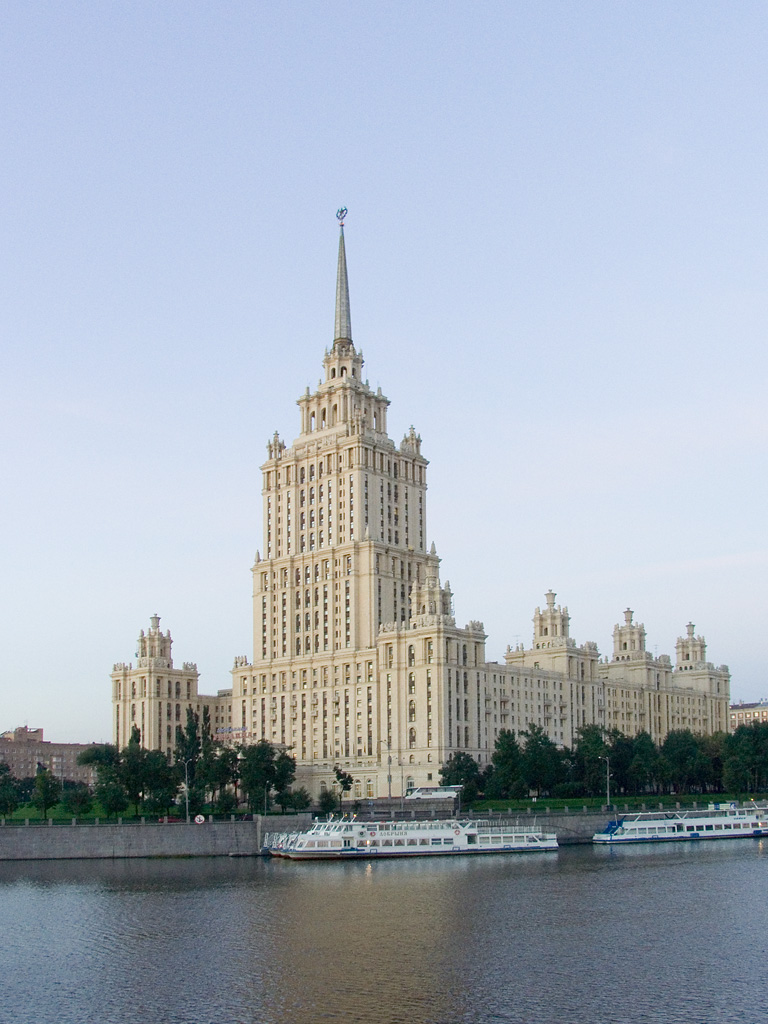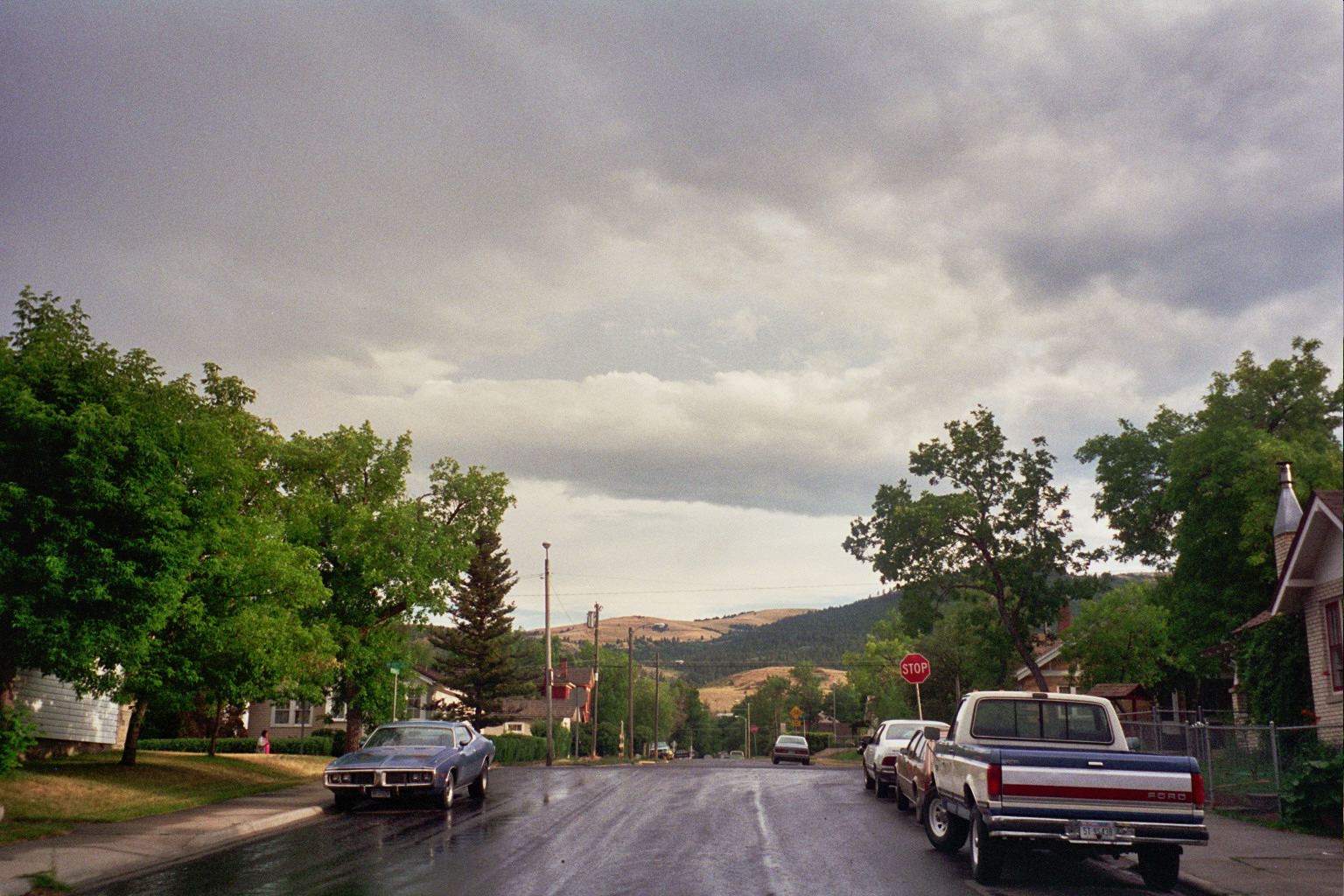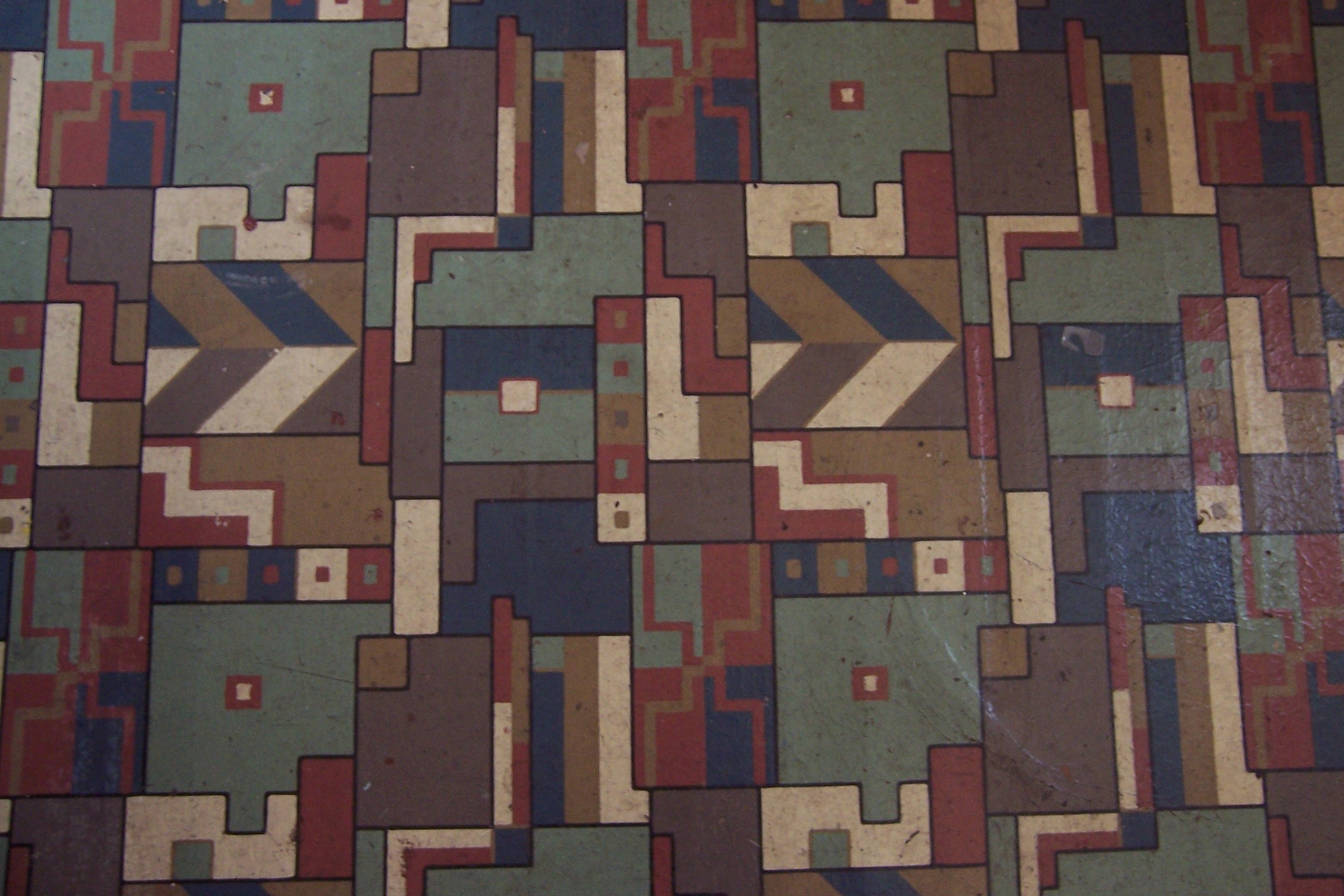|
Kudrinskaya Square Building
The Kudrinskaya Square Building is a building in Moscow, one of Seven Sisters Of Moscow Stalinist skyscrapers, designed by Mikhail Posokhin () and Ashot Mndoyants (). Design and construction features The building was richly decorated but lacked a unified stylistic direction. The parapets are in the ancient Roman style. The lobbies decorated with marble columns, stained-glass windows, and lamps in the form of candelabra are a reminiscence of Gothic interiors. The pointed turrets around the spire resemble the domes of an Eastern Orthodox church. On the roof of the stylobate, there are sculptural portraits of Soviet workers and soldiers. One of the stylistic features of the building were the stained glass windows, which are located in the halls above the lifts and the windows of the deli. Motifs from Russian folk culture were used in the design. The floors in the living rooms and corridors of the flats were laid with oak parquet, the bathrooms were tiled with metal tiles, and ... [...More Info...] [...Related Items...] OR: [Wikipedia] [Google] [Baidu] |
Stalinist Architecture
Stalinist architecture (), mostly known in the former Eastern Bloc as Stalinist style or socialist classicism, is the architecture of the Soviet Union under the leadership of Joseph Stalin, between 1933 (when Boris Iofan's draft for the Palace of the Soviets was officially approved) and 1955 (when Nikita Khrushchev condemned "excesses" of the past decades and disbanded the Soviet Academy of Architecture). Stalinist architecture is associated with the Socialist realism school of art and architecture. Features As part of the Soviet policy of rationalization of the country, all cities were built to a general urban planning, development plan. Each was divided into districts, with allotments based on the city's geography. Projects would be designed for whole districts, visibly transforming a city's architectural image. The interaction of the state with the architects would prove to be one of the features of this time. The same building could be declared a Formalism (art), formalist b ... [...More Info...] [...Related Items...] OR: [Wikipedia] [Google] [Baidu] |
Eastern Orthodox Church
The Eastern Orthodox Church, officially the Orthodox Catholic Church, and also called the Greek Orthodox Church or simply the Orthodox Church, is List of Christian denominations by number of members, one of the three major doctrinal and jurisdictional groups of Christianity, with approximately 230 million baptised members. It operates as a Communion (Christian), communion of autocephalous churches, each governed by its Bishop (Orthodox Church), bishops via local Holy Synod, synods. The church has no central doctrinal or governmental authority analogous to the pope of the Catholic Church. Nevertheless, the Ecumenical Patriarch of Constantinople is recognised by them as ''primus inter pares'' (), a title held by the patriarch of Rome prior to 1054. As one of the oldest surviving religious institutions in the world, the Eastern Orthodox Church has played an especially prominent role in the history and culture of Eastern Europe, Eastern and Southeastern Europe. Since 2018, the ... [...More Info...] [...Related Items...] OR: [Wikipedia] [Google] [Baidu] |
Residential Buildings Completed In 1954
A residential area is a land used in which housing predominates, as opposed to industrial and commercial areas. Housing may vary significantly between, and through, residential areas. These include single-family housing, multi-family residential, or mobile homes. Zoning for residential use may permit some services or work opportunities or may totally exclude business and industry. It may permit high density land use or only permit low density uses. Residential zoning usually includes a smaller FAR (floor area ratio) than business, commercial or industrial/manufacturing zoning. The area may be large or small. Overview In certain residential areas, especially rural, large tracts of land may have no services whatever, such that residents seeking services must use a motor vehicle or other transportation, so the need for transportation has resulted in land development following existing or planned transport infrastructure such as rail and road. Development patterns may be regul ... [...More Info...] [...Related Items...] OR: [Wikipedia] [Google] [Baidu] |
Rough Guides
Rough Guides is a travel company that offers tailor-made trips planned and arranged by local travel experts based in destinations around the world. Originally established as a guidebook publisher in 1982, Rough Guides expanded into customized travel services in 2018. History The first Rough Guide was ''The Rough Guide to Greece''. In 1995, when Rough Guides were selling around a million books a year, Mark Ellingham entered into a pioneering agreement with HotWired Ventures, the digital offshoot of Wired Ventures, the then-publisher of WIRED magazine. The deal offered free online access to the full text of ''The Rough Guide to the USA'' via the World Beat section of HotWired. Ellingham stated at the time that publishing the guides online would facilitate easier updates. "If you could send me an e-mail from Senegal saying this hotel's closed down, I would just key it in," he told the ''San Francisco Chronicle''. "The online book would take on a life of its own". In May 2007, M ... [...More Info...] [...Related Items...] OR: [Wikipedia] [Google] [Baidu] |
USSR
The Union of Soviet Socialist Republics. (USSR), commonly known as the Soviet Union, was a List of former transcontinental countries#Since 1700, transcontinental country that spanned much of Eurasia from 1922 until Dissolution of the Soviet Union, it dissolved in 1991. During its existence, it was the list of countries and dependencies by area, largest country by area, extending across Time in Russia, eleven time zones and sharing Geography of the Soviet Union#Borders and neighbors, borders with twelve countries, and the List of countries and dependencies by population, third-most populous country. An overall successor to the Russian Empire, it was nominally organized as a federal union of Republics of the Soviet Union, national republics, the largest and most populous of which was the Russian SFSR. In practice, Government of the Soviet Union, its government and Economy of the Soviet Union, economy were Soviet-type economic planning, highly centralized. As a one-party state go ... [...More Info...] [...Related Items...] OR: [Wikipedia] [Google] [Baidu] |
View From Imperia Tower Moscow 04-2014 Img02
Acornsoft was the software arm of Acorn Computers, and a major publisher of software for the BBC Micro and Acorn Electron. As well as games, it also produced a large number of educational titles, extra computer languages and business and utility packages – these included word processor ''VIEW'' and the spreadsheet ''ViewSheet'' supplied on ROM and cartridge for the BBC Micro/Acorn Electron and included as standard in the BBC Master and Acorn Business Computer. History Acornsoft was formed in late 1980 by Acorn Computers directors Hermann Hauser and Chris Curry, and David Johnson-Davies, author of the first game for a UK personal computer and of the official Acorn Atom manual "Atomic Theory and Practice". David Johnson-Davies was managing director and in early 1981 was joined by Tim Dobson, Programmer and Chris Jordan, Publications Editor. While some of their games were clones or remakes of popular arcade games (e.g. ''Hopper'' is a clone of Sega's ''Frogger'', '' Snapper' ... [...More Info...] [...Related Items...] OR: [Wikipedia] [Google] [Baidu] |
Linoleum
Linoleum is a floor covering made from materials such as solidified linseed oil (linoxyn), Pine Resin, pine resin, ground Cork (material), cork dust, sawdust, and mineral fillers such as calcium carbonate, most commonly on a Hessian fabric, hessian or canvas backing. Pigments are often added to the materials to create the desired color finish. Commercially, the material has been largely replaced by sheet vinyl flooring, although in the UK and Australia this is often still referred to as "lino". The finest linoleum floors, known as "inlaid", are extremely durable, and are made by joining and inlaying solid pieces of linoleum. Cheaper patterned linoleum comes in different grades or gauges, and is printed with thinner layers which are more prone to wear and tear. High-quality linoleum is flexible and thus can be used in buildings where a more rigid material (such as Tile#Floor tiles, ceramic tile) would crack. Technology Linoleum in essence consists of two components, a polymer ... [...More Info...] [...Related Items...] OR: [Wikipedia] [Google] [Baidu] |
Folklore Of Russia
The Russian folklore, i.e., the folklore of Russian people, takes its roots in the pagan beliefs of ancient Slavs and now is represented in the Russian fairy tales. Epic Russian bylinas are also an important part of Slavic paganism. The oldest bylinas of Kievan cycle were recorded in the Northwestern Federal District, Russian North, especially in Karelia, where most of the Finnish people, Finnish national epic Kalevala was recorded as well. In the late 19th-century Russian fairy tales began being translated into English, with ''Russian Folk Tales'' (1873) by William Ralston Shedden-Ralston, William Ralston, and ''Tales and Legends from the Land of the Tzar'' (1890) by Edith Hodgetts. Many Russian fairy tales and bylinas have been adapted for Russian animation, animation films, or for feature movies by prominent directors such as Aleksandr Ptushko (''Ilya Muromets (film), Ilya Muromets'', ''Sadko (film), Sadko'') and Aleksandr Rou (''Jack Frost (1964 film), Morozko'', ''Vasilisa th ... [...More Info...] [...Related Items...] OR: [Wikipedia] [Google] [Baidu] |
Stylobate
In classical Greek architecture, a stylobate () is the top step of the crepidoma, the stepped platform upon which colonnades of temple columns are placed (it is the floor of the temple). The platform was built on a leveling course that flattened out the ground immediately beneath the temple. Etymology The term ''stylobate'' comes from the Ancient Greek , consisting of (stylos), "column", and (bainein), "to stride, walk". Terminology Some methodologies use the word ''stylobate'' to describe only the topmost step of the temple's base, while stereobate is used to describe the remaining steps of the platform beneath the stylobate and just above the leveling course. Others, like John Lord, use the term to refer to the entire platform. Architectural use The stylobate was often designed to relate closely to the dimensions of other elements of the temple. In Greek Doric temples, the length and width of the stylobate were related, and in some early Doric temples the column h ... [...More Info...] [...Related Items...] OR: [Wikipedia] [Google] [Baidu] |
Turret (architecture)
In architecture, a turret is a small circular tower, usually notably smaller than the main structure, that projects outwards from a wall or corner of that structure. Turret also refers to the small towers built atop larger tower structures. Etymology The word ''turret'' originated in around the year 1300 from ''touret'' which meant "small tower rising from a city wall, castle, or other larger building." ''Touret'' came from the Old French term ''torete'' which is the diminutive form of ''tour'', meaning “tower.” ''Tour'' dates back to the Latin word ''turris'' which also means “tower.” There is a record from 1862 of ''turret'' being used to mean "low, flat gun tower on a warship." Around this time, the word split into two separate definitions, with this definition being the one that goes on to describe gun turrets, a separate idea from the architectural element. Uses Turrets initially arose on castles out of a defensive need for greater visibility. Since they proje ... [...More Info...] [...Related Items...] OR: [Wikipedia] [Google] [Baidu] |
Presnensky District
Presnensky District (), commonly called Presnya (), is a district of Central Administrative Okrug of the federal city of Moscow, Russia. Population: The district is home to the Moscow Zoo, White House of Russia, Kudrinskaya Square Building, Patriarch Ponds, Vagankovo Cemetery, and Moscow-City financial district (under construction). History The name of Presnya (noun; adjective: Presnensky) district is inherited from the Presnya River, now flowing largely in an underground pipe and entering the Moskva River immediately west of the White House of Russia. Ponds that were set up on Presnya River and its tributaries in the seventeenth century survive as Patriarshy Pond (one of three ponds formerly on the ''Bubna'' stream in the Goat Marsh area) and the Moscow Zoo ponds (on the Presnya River proper). Another small north–south brook flows in piping two kilometers west from Presnya river. Today, it fills four ponds separating the old Presnya district from the Expocenter and Mos ... [...More Info...] [...Related Items...] OR: [Wikipedia] [Google] [Baidu] |




